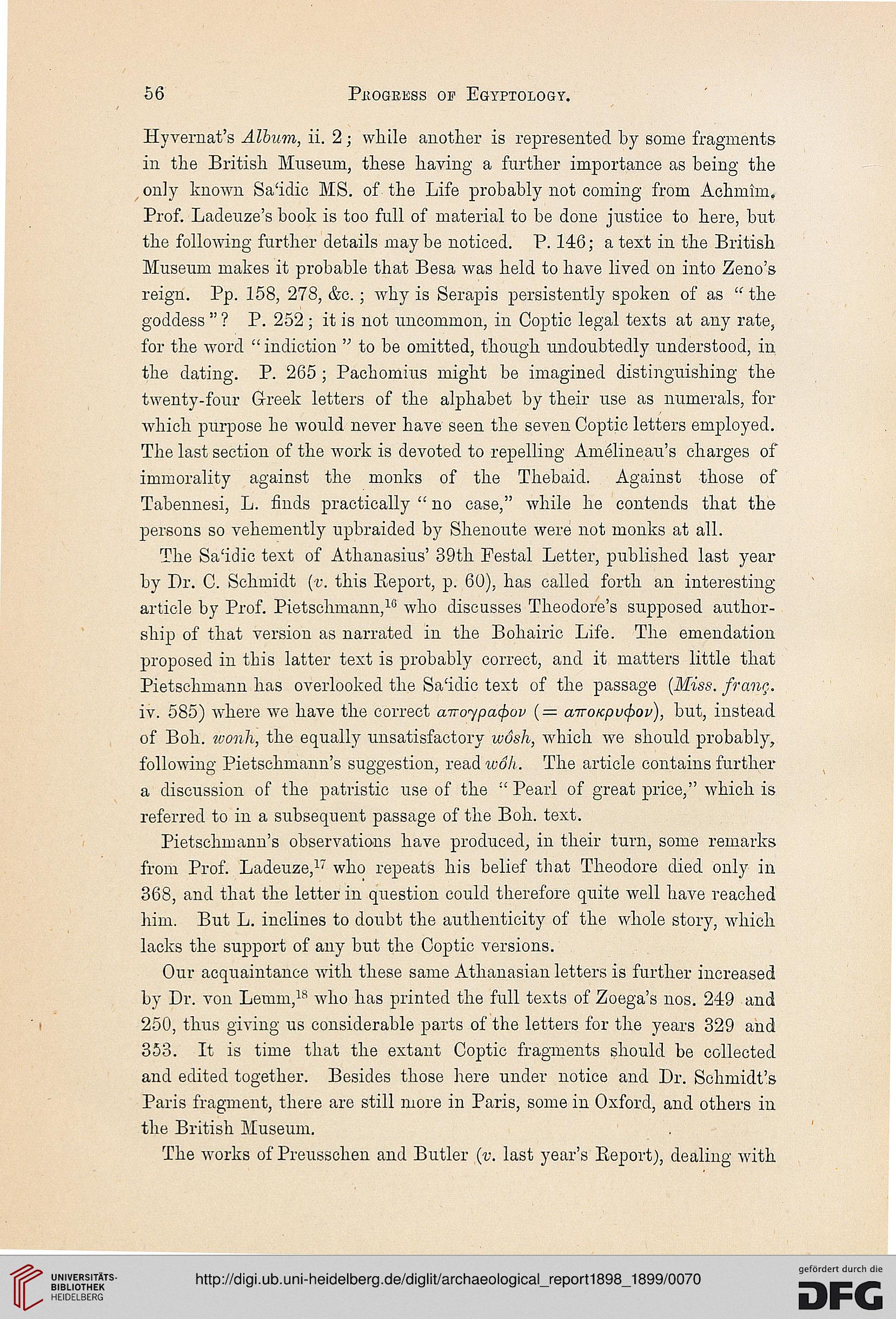56
Progress of Egyptology.
Hyvernat's Album, ii. 2; while another is represented by some fragments
in the British Museum, these having a further importance as being the
, only known Sa'idic MS. of the Life probably not coming from Achmim.
Prof. Ladeuze's book is too full of material to be done justice to here, but
the following further details maybe noticed. P. 146; a text in the British
Museum makes it probable that Besa was held to have lived on into Zeno's
reign. Pp. 158, 278, &c.; why is Serapis persistently spoken of as " the
goddess " ? P. 252 ; it is not uncommon, in Coptic legal texts at any rate,
for the word " indiction " to be omitted, though undoubtedly understood, in
the dating. P. 265 ; Pachomius might be imagined distinguishing the
twenty-four Greek letters of the alphabet by their use as numerals, for
which purpose he would never have seen the seven Coptic letters employed.
The last section of the work is devoted to repelling Amelineau's charges of
immorality against the monks of the Thebaicl. Against those of
Tabennesi, L. finds practically " no case," while he contends that the
persons so vehemently upbraided by Shenoute were not monks at all.
The Sa'idic text of Athanasius' 39th Festal Letter, published last year
by Dr. C. Schmidt (v. this Keport, p. 60), has called forth an interesting
article by Prof. Pietschmann,18 who discusses Theodore's supposed author-
ship of that version as narrated in the Bohairic Life. The emendation
jjroposed in this latter text is probably correct, and it matters little that
Pietschmann has overlooked the Sa'idic text of the passage (Miss, franc,.
iv. 585) where we have the correct a-rroypaifiov (= atroKpvfyov), but, instead
of Boh. wonli, the equally unsatisfactory wosh, which we should probably7,
following Pietschmann's suggestion, read woh. The article contains further
a discussion of the patristic use of the "Pearl of great price," which is
referred to in a subsequent passage of the Boh. text.
Pietschmann's observations have produced, in their turn, some remarks
from Prof. Ladeuze,17 who repeats his belief that Theodore died only in
368, and that the letter in question could therefore quite well have reached
him. But L. inclines to doubt the authenticity of the whole story, which
lacks the support of any but the Coptic versions.
Our acqimintance with these same Athanasian letters is further increased
by Dr. von Lemm,18 who has printed the full texts of Zoega's nos. 249 and
250, thus giving us considerable parts of the letters for the years 329 and
353. It is time that the extant Coptic fragments should be collected
and edited together. Besides those here under notice and Dr. Schmidt's
Paris fragment, there are still more in Paris, some in Oxford, and others in
the British Museum.
The works of Preusschen and Butler (v. last year's Beport), dealing with
Progress of Egyptology.
Hyvernat's Album, ii. 2; while another is represented by some fragments
in the British Museum, these having a further importance as being the
, only known Sa'idic MS. of the Life probably not coming from Achmim.
Prof. Ladeuze's book is too full of material to be done justice to here, but
the following further details maybe noticed. P. 146; a text in the British
Museum makes it probable that Besa was held to have lived on into Zeno's
reign. Pp. 158, 278, &c.; why is Serapis persistently spoken of as " the
goddess " ? P. 252 ; it is not uncommon, in Coptic legal texts at any rate,
for the word " indiction " to be omitted, though undoubtedly understood, in
the dating. P. 265 ; Pachomius might be imagined distinguishing the
twenty-four Greek letters of the alphabet by their use as numerals, for
which purpose he would never have seen the seven Coptic letters employed.
The last section of the work is devoted to repelling Amelineau's charges of
immorality against the monks of the Thebaicl. Against those of
Tabennesi, L. finds practically " no case," while he contends that the
persons so vehemently upbraided by Shenoute were not monks at all.
The Sa'idic text of Athanasius' 39th Festal Letter, published last year
by Dr. C. Schmidt (v. this Keport, p. 60), has called forth an interesting
article by Prof. Pietschmann,18 who discusses Theodore's supposed author-
ship of that version as narrated in the Bohairic Life. The emendation
jjroposed in this latter text is probably correct, and it matters little that
Pietschmann has overlooked the Sa'idic text of the passage (Miss, franc,.
iv. 585) where we have the correct a-rroypaifiov (= atroKpvfyov), but, instead
of Boh. wonli, the equally unsatisfactory wosh, which we should probably7,
following Pietschmann's suggestion, read woh. The article contains further
a discussion of the patristic use of the "Pearl of great price," which is
referred to in a subsequent passage of the Boh. text.
Pietschmann's observations have produced, in their turn, some remarks
from Prof. Ladeuze,17 who repeats his belief that Theodore died only in
368, and that the letter in question could therefore quite well have reached
him. But L. inclines to doubt the authenticity of the whole story, which
lacks the support of any but the Coptic versions.
Our acqimintance with these same Athanasian letters is further increased
by Dr. von Lemm,18 who has printed the full texts of Zoega's nos. 249 and
250, thus giving us considerable parts of the letters for the years 329 and
353. It is time that the extant Coptic fragments should be collected
and edited together. Besides those here under notice and Dr. Schmidt's
Paris fragment, there are still more in Paris, some in Oxford, and others in
the British Museum.
The works of Preusschen and Butler (v. last year's Beport), dealing with





